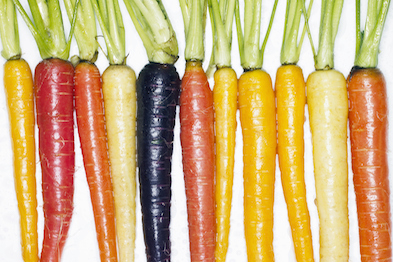Everything That is Old is New Again–Veggie Edition 1

There always seems to be the “vegetable du jour,” the most buzzed about veggie on the market…think kale. But there’s something to be said for the tried-and-true veggies your grandmother’s grandmother had in her kitchen. So, here is our list of the best old school veggies, because everything old is new again!
Let’s start with the lowly carrot. The vibrant orange hue should give you a clue as to how great this veggie is. The color indicates high levels of carotenoids, powerful compounds that research has linked to a reduced risk of some types of cancer and eye disease. As for the specifics, 1 cup of sliced carrots contains 50 calories, 3 grams of fiber, a decent amount of vitamin C, and a whopping 408% of your daily vitamin A needs. Tossing a few slices into your salad is probably the easiest way to get more of this powerhouse in your diet. Carrots can also play the roasted game just as well as cauliflower or brussels sprouts (another trendy veggie). For a tasty take on roasted carrots, try this simple recipe –http://cooking.nytimes.com/recipes/1014219-roasted-carrots-with-parsley-and-thyme
Another “old school” veggie that’s healthier than you’d think is Bok Choy. You’ve probably seen it a thousand times on your grocer’s shelves but have probably always passed it by. This member of the cruciferous vegetable family doesn’t get very much attention here in the United States. Consider it your secret weapon because 1 cup contains only 10 calories, but gives you a good dose of fiber and vitamins A and C. Studies indicate eating cruciferous veggies may also help prevent certain types of cancer. And it’s really inexpensive! This veggies is a staple in Chinese cuisine, so try it in a stir-fry or steam it with some fish. The texture is also perfect for grilling. Here’s a simple stir-fry recipe that’s sure to delight! http://www.epicurious.com/recipes/food/views/stir-fried-sesame-baby-bok-choy-51180000
What about onions? Most people consider it a “flavoring” rather than a vegetable, but consider this recent study from the British Journal of Nutrition that found regular doses of onion skin extract helped lower blood pressure for adults with hypertension. Onions are also pretty smart for those watching their weight. WebMD reported an entire allium is just 63 calories and also contains loads of vitamin C. Onions make a great base for any soup, stew, or braise. You can also caramelize them for a sweet topping, which goes great on pizza and sandwiches. Caramelized onions are a bit tricky to make so here’s how to “perfect your form” courtesy of Bon Appétit! http://www.bonappetit.com/test-kitchen/common-mistakes/article/caramelized-onions-common-mistakes-avoid
Onto peas and we’re talking the frozen kind! The kind your mom used to buy at the grocery store. Think fresh is always best? Think again. When any type of produce is picked, it immediately starts losing nutritional value. Peas are particularly finicky and lose their nutrients a lot faster than sturdier vegetables. In fact, one study indicated peas any older than three days could be less nutritious than frozen ones. A quick glance at the label on the package shows this freezer-aisle staple is a really smart choice. A ½-cup serving of frozen peas will set you back 62 calories and give you a decent amount of vitamins A and C, 4.4 grams of fiber, and an impressive 4.1 grams of protein. Pea protein is quickly becoming one of the go-to ingredients for nutrition bars, but you may as well save your money and get the real thing. Check out this amazing risotto recipe from Serious Eats! http://www.seriouseats.com/recipes/2012/05/spring-vegetable-risotto-asparagus-zucchini-fava-morel-snap-pea-recipe.html
Near the end of our list is celery…how boring, right? Wrong! This crunchy veggie is a lot more nutritious than the blue cheese dressing and fried wings it usually accompanies. According to the USDA’s nutrient database, one cup of chopped stalks is only 16 calories and provides you with a decent amount of vitamin A and folate. Most notably, though, celery is an excellent source of vitamin K, a key nutrient for bone and blood health. If that’s not enough to convince you to chow down, consider the boost it could give your sex life. Men’s Health revealed celery is loaded with pheromones, chemicals that get you “in the mood.” The effect is nearly immediate, so munch away. If you don’t like eating celery raw, try some cooked preparations to jazz things up. It’s surprisingly delicious when roasted. Just chop the stalks into 1-inch lengths, toss with olive oil, tarragon, salt, and pepper, then bake the veggies in a hot oven until the edges brown.
And last on our old-school veggies list – radishes! This water-packed veggie offers more than just a spicy kick for your salad. WebMD said a full cup contains 19 calories plus a good amount of vitamin C and fiber. Radishes are also filled with phytosterols, a type of compound that can help lower cholesterol, according to Cleveland Clinic. Skip the bagged ones and go for bunches with the greens still attached. They’re often much fresher and you basically get a bonus vegetable. Add the greens to salads or sauté them like spinach. The tops tend to be sandy, so give them a good rinse prior to cooking. As for the root end, you can give them the skillet treatment as well. This smart recipe from Rodale’s Organic Life calls for both radishes and their leafy tops. http://www.rodalesorganiclife.com/food/sauteed-radishes-garlic-greens





